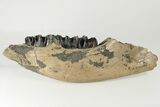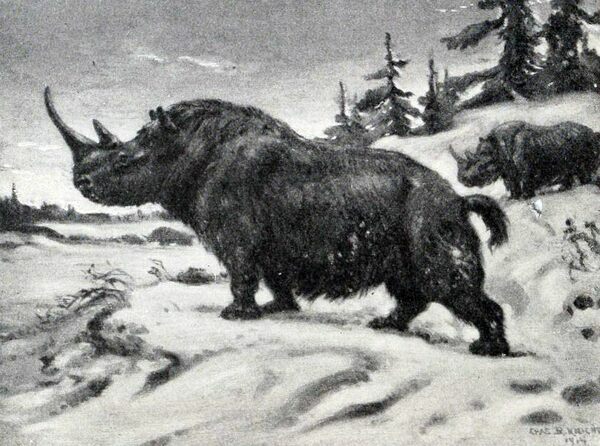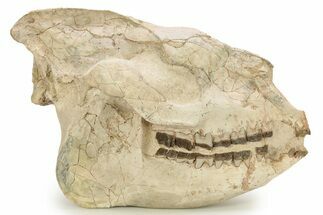This Specimen has been sold.
17" Fossil Woolly Rhino (Coelodonta) Right Mandible - North Sea
This is a well preserved, 17" long mandible half (right side lower jaw) of a woolly rhino (Coelodonta antiquitatis). It comes from the Pleistocene age North Sea deposits, making it between 20,000 to 50,000 (most likely 40,000) years old! It is beautifully intact, featuring six teeth that are still in their natural position. One tooth at the proximal end of the jaw is unerupted, indicating this jaw came from a subadult rhino. None of the teeth have been repaired or mounted in place, and the bone has undergone no repair or restoration. The rock has been meticulously prepped away to expose the bone, including a foramen at the distal-lateral side of the jaw that would have housed blood vessels and nerves.
Woolly rhino material is much rarer than the mammoth material more commonly collected from the North Sea deposits. Comes with an acrylic/metal display stand.
Woolly rhino material is much rarer than the mammoth material more commonly collected from the North Sea deposits. Comes with an acrylic/metal display stand.
The woolly rhinoceros (Coelodonta antiquitatis) is an extinct species of rhinoceros that was common throughout Europe and northern Asia during the Pleistocene epoch. As the last and most derived member of the Pleistocene rhinoceros lineage, the woolly rhinoceros was well adapted to its environment. Stocky limbs and thick woolly fur made it well suited to the steppe-tundra environment that it lived in.
The wooly rhino grew to 11 feet in length and stood 6 feet at its shoulders. It had a huge pair of horns that grew inline on its snout. The front horn grew to lengths in excess of 3 feet. Like modern rhinos, wooly rhinoceroses had horns composed of keratin. They first appeared in the fossil record 1.8 million years ago and went extinct as recently as 10,000 years ago.
The wooly rhino grew to 11 feet in length and stood 6 feet at its shoulders. It had a huge pair of horns that grew inline on its snout. The front horn grew to lengths in excess of 3 feet. Like modern rhinos, wooly rhinoceroses had horns composed of keratin. They first appeared in the fossil record 1.8 million years ago and went extinct as recently as 10,000 years ago.
These Pleistocene fossils were dredged up by fishing trawlers in the the North Sea between Britain and Denmark. Fishermen routinely find mammoth teeth and many Ice Age fossils in their nets: given the chance that a fossil is accidentally gathered in a net is slim, the sea floor is probably littered with the remains of millions of animals. The cold temperatures and low-oxygen environment of the North Sea have aided in the preservation of these teeth and bones.
While these fossils have been pulled up in nets for more than a century, they used to be frequently discarded. It wasn't until the past two decades that this material has begun to be systematically collected and studied. By recording the locations of their finds and allowing scientists to make observations before the more common material is made available, much has been learned about the fauna that once roamed the land that now lies 30 to 150 feet below the North Sea waters.
You can read more information about this at the following link.
http://www.independent.co.uk/news/science/the-watery-grave-of-europes-monsters-1744973.html
While these fossils have been pulled up in nets for more than a century, they used to be frequently discarded. It wasn't until the past two decades that this material has begun to be systematically collected and studied. By recording the locations of their finds and allowing scientists to make observations before the more common material is made available, much has been learned about the fauna that once roamed the land that now lies 30 to 150 feet below the North Sea waters.
You can read more information about this at the following link.
http://www.independent.co.uk/news/science/the-watery-grave-of-europes-monsters-1744973.html
These fossils have been submerged in salt water for over ten thousand years, so they had to go through a lengthy stabilization process so they do not disintegrate. The fossils are immersed for six weeks in constantly refreshed fresh water. They are then slowly dried and stabilized with a museum standard conservation layer, which not only preserves the fossils but also brings out their natural stunning coloring. This process takes around two to three months to complete.
SPECIES
Coelodonta antiquitatis
LOCATION
North Sea, Doggerland Bank
SIZE
17 x 5.2 x 2.3"
CATEGORY
SUB CATEGORY
ITEM
#200805
We guarantee the authenticity of all of our specimens.
 Reviews
Reviews


















